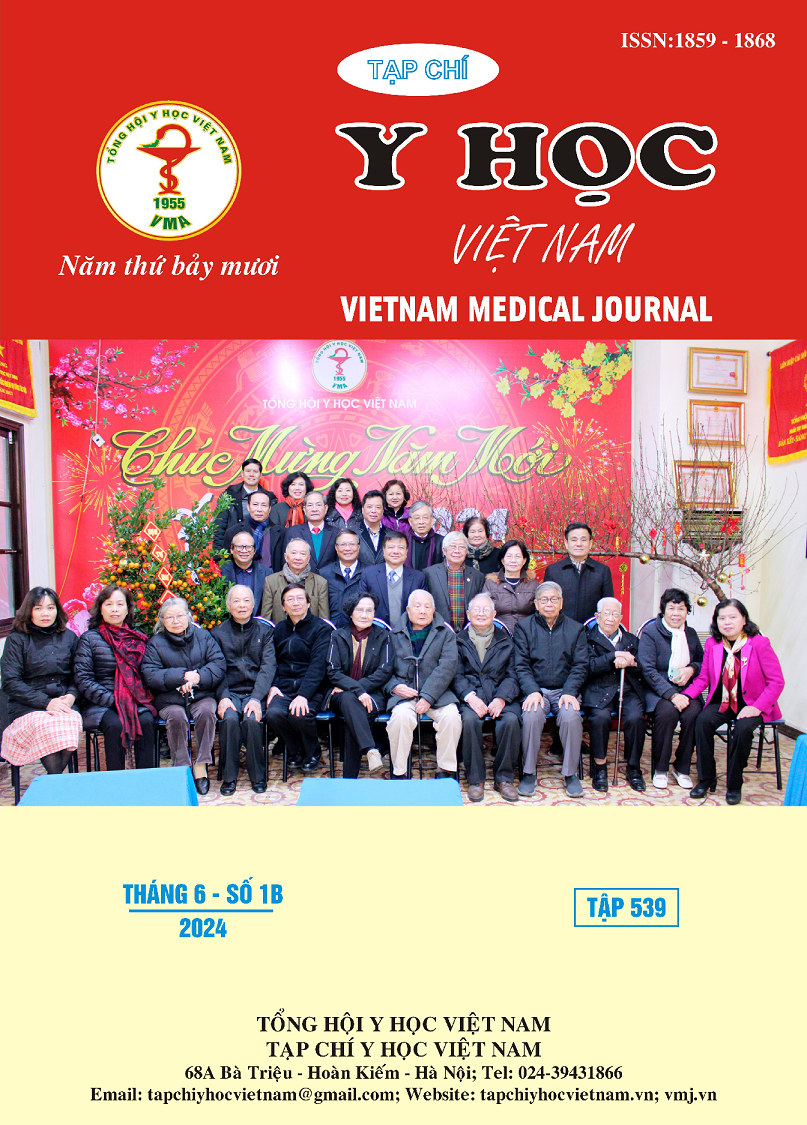ASSESSMENT OF REFRACTIVE OUTCOMES AFTER A FIVE-YEAR TREATMENT PERIOD FOR RETINOPATHY OF PREMATURITY WITH INTRAVITREAL BEVACIZUMAB INJECTION AT VIET NAM NATIONAL CHILDREN’S HOSPITAL
Main Article Content
Abstract
Objective: Assessment of refractive outcomes five years post-treatment for retinopathy of prematurity with intraocular Bevacizumab injection at Viet Nam National Children’s Hospital. Discussion on related factors impacting refractive results. Materials and methods: the study was conducted on patients diagnosed with retinopathy of prematurity type 1 who underwent intravitreal Bevacizumab injection at the Department of Ophthalmology – National Children’s Hospital before February 2018. This retrospective cross-sectional descriptive study encompasses 224 eyes of 115 patients. Results: The mean spherical equivalent was -1.72 ± 4,17D. This encompassed 105 myopic eyes (47,2%), with an average myopia power was -3,69 ± 4,01D. Additionally, 30 eyes exhibited hyperopia (13,6%), with an average hyperopia power was + 2.08 ± 1,22D. Among these, 45 eyes were diagnosed with high myopia, representing 20,2% of the sample, while 7 eyes had high hyperopia, accounting for 3,2%. Conclusion: The prevalence of refractive errors among patients who had retinopathy of prematurity treated with intravitreal Bevacizumab injection is considerable, at 60,8%, with myopia being the majority, constituting 47,2% of cases. Furthermore, significant associations exist between the development of myopia and gestational age, birth weight, and disease severity. Recommendation: children who have undergone treatment for retinopathy of prematurity with intravitreal Bevacizumab injection need to have routine vision screening to promptly identify and manage refractive errors, thereby preventing the risk of amblyopia complication.
Article Details
References
2. Hakeem A, Mohamed G, Othman M. Retinopathy of prematurity: a study of prevalence and risk factors. Middle East Afr J Ophthalmol. 2012;19(3):289-294.
3. Mintz-Hittner H, Kennedy K, Chuang A, BEAT-ROP Cooperative Group. Efficacy of intravitreal bevacizumab for stage 3+ retinopathy of prematurity. N Engl J Med. 2011;364(7):603-615.
4. Wu WC, Yeh PT, Chen SN, Yang CM, Lai CC, Kuo HK. Effects and complications of bevacizumab use in patients with retinopathy of prematurity: a multicenter study in Taiwan. Ophthalmology. 2011;118(1):176-183.
5. Wu WC, Kuo HK, Yeh PT, Yang CM, Lai CC, Chen SN. An updated study of the use of bevacizumab in the treatment of patients with prethreshold retinopathy of prematurity in taiwan. Am J Ophthalmol. 2013;155(1):150-158.e1
6. Murakami T, Sugiura Y, Okamoto F, et al. Comparison of 5-year safety and efficacy of laser photocoagulation and intravitreal bevacizumab injection in retinopathy of prematurity. Graefes Arch Clin Exp Ophthalmol. 2021;259(9):2849-2855.
7. Nguyễn Xuân Tịnh (2012), Điều trị bệnh võng mạc trẻ đẻ non hình thái nặng bằng tiêm thuốc Bevacizumab (Avastin) nội nhãn - kết quả sau hơn một năm theo dõi. Tạp chí Nhãn khoa Việt Nam. 2012(28).
8. Martínez-Castellanos MA, Schwartz S, Hernández-Rojas ML, et al. Long-term effect of antiangiogenic therapy for retinopathy of prematurity up to 5 years of follow-up. Retina. 2013;33(2):329-338.
9. Isaac M, Mireskandari K, Fallaha N, et al. Long-term outcomes of type 1 retinopathy of prematurity following monotherapy with bevacizumab: a Canadian experience. Can J Ophthalmol. 2023;58(6):553-558.


